Through photos and videos, EE World covers some of the active and passive components that RF and wireless engineers need to connect us all.
 The exhibit hall at the 2023 International Microwave Symposium in San Diego consisted of 560 exhibitors, too many for this editor to visit in three days. For 2023, we improved our video coverage with the addition of a dual wireless Lavalier microphone set. The two mics pair themselves over Bluetooth to a receiver attached to my iPhone.The case wirelessly charges the two mics or you can charge them both with a dual USB-A to USB-C cable (included). It worked so well that several people asked for a link to buy one themselves. Amazon sells dozens of these sets, including those with USB-C ports on the receiver for use with Android phones. Most of these wireless microphone kits look the same.
The exhibit hall at the 2023 International Microwave Symposium in San Diego consisted of 560 exhibitors, too many for this editor to visit in three days. For 2023, we improved our video coverage with the addition of a dual wireless Lavalier microphone set. The two mics pair themselves over Bluetooth to a receiver attached to my iPhone.The case wirelessly charges the two mics or you can charge them both with a dual USB-A to USB-C cable (included). It worked so well that several people asked for a link to buy one themselves. Amazon sells dozens of these sets, including those with USB-C ports on the receiver for use with Android phones. Most of these wireless microphone kits look the same.
At IMS2022 in Denver, I used an analog mic that connects to my phone through a 1/8-in. audio cable. Then for APEC 2023, I inadvertently left the cable at home and the mic was useless. The best I could do was to use the phone’s internal mic, cupping my hand around it to amplify the speaker’s voice. Someone at one of the booths brought out a wireless microphone pair for me to use. After that, I had to get a set of my own.
With the new microphone set in my pocket, I set out to conduct interviews at IMS 2023. The best part: I always remembered to collect the two mics before leaving each booth. Neither was lost.
See EE World’s IMS 2023 coverage of connectors on Connector Tips and test equipment on Test and Measurement Tips. See IMS 2023: keynote analyzes early undersea cables to learn how transmission lines have affected communications since the 1800s.
| While most exhibits at IMS focus on microwave and mmWave components, Aethertek was there with its complete 5G radio units. The photo at right shows the company’s IRIS III 8×8 antenna-in-module beamforming unit installed in a small cell. The company’s radio units cover the 5G bands n257, n258, and n261. | |
| Analog Devices unvieled the Apollo MxFE combination 4/8 channel ADC/DAC/DSP for capturing, creating, and analyzing RF signals. See EE World full coverage at SoC ecosystem combines data converters with DSP. | |
| Guerilla RF introduced a series of ¼ W linear power amplifiers. Based on InGaP HBT process, the GRF5526, GRF5536 and GRF5536W serve 5G wireless infrastructure applications that require native linearity over large 100 MHz bandwidths and temperatures from -40°C to 105°C.
The GRF5526/GRF5526W and GRF5536/GRF5536W operate at frequencies of 2.3 GHz to 2.7 GHz and 3.3 GHz to 4.2 GHz respectively. Those frequencies cover the n7, n30, n38, n40, n41, n48, n53, n77, n88 and n90 5G NR bands. They deliver 23 dBm (typ.) of linear power over their entire temperature range while maintaining adjacent channel leakage ratio (ACLR) levels of better than -45 dBc and error-vector magnitude (EVM) levels <1% without the need for digital predistortion (DPD). That’s critical for cellular applications that include home and commercial repeaters/boosters, femtocells, and picocells, as well as cable loss compensators found in automotive “shark fin” antennas. The company also discussed with EE World the GRF5607 and GRF5608, the first in a new line of ½ W linear power amplifiers designed specifically for 5G wireless infrastructure applications requiring exceptional native linearity over temperature extremes of -40°C to 85°C. Spanning frequency ranges of 703 MHz to 748 MHz and 746 MHz to 830 MHz, respectively, the GRF5607 and GRF5608 operate in the n12, n14, n18, n20, and n28 5G new radio (NR) bands. The devices typically deliver 26 dBm of linear power over the entire -40°C to 85°C temperature range while maintaining ACLR levels of better than -45 dBc and EVM levels <1.2% – all without DPD. |
|
| imec and AT&S announced an integration approach that combines D-band (110 GHz to 170 GHz) chips and waveguides that can result in low-cost, mass-manufacturable PCBs. In a press release, the companies claim that hollow air-filled substrate-integrated waveguide (AFSIW) technology with fully metalized sidewalls offers significantly reduced signal loss compared to substrate-integrated waveguides (SIWs) that use rows of vias and the planar interconnect technology used in current communication and radar systems. Despite this intrinsic benefit, a mass-production approach for PCBs with integrated AFSIW waveguides is currently unavailable.” | |
|
IMS isn’t only about wireless, for wireline communications can make appearances. In the Menlo Micro booth, Stuart Yang explained the company’s MM5620 high-frequency switch. In the video, Yang provided a live demonstration of the MM5620 passing a 64 Gb/sec PAM4 signal. |
|
| Microchip introduced the not-yet-released DSC500 6-output PCIe Gen 1-6 clock-tree-on-a-chip. It contains a MEMs clock generator with two integer dividers, two fractional dividers, and Spread Spectrum outputs. The MEMS resonator is programmed at the factory, which you can program the device to divide down to your final frequency. Microchip also announced the 5071B cesium atomic clock, an upgrade from the 5071A. The 5071B provides absolute frequency accuracy of 5E-13 over all specified environmental conditions for the life of the product. | |
| RF and microwave systems use a variety of passive components. Waveguides steer energy from a source to one or more destinations. Microwave Development Labs manufactures waveguides, primarily for aerospace and defense applications. In the video, design and manufacturing engineer John Kane explained to EE World how the company’s waveguide products work. The size of the waveguide sets its frequency range. Kane used the company’s rigid waveguide data “slide rule” to show how to select a waveguide based on frequency. | |
| Quantic companies exhibited numerous products. Specifically, Quantic Eulex exhibited microwave and mmWave capacitors. The company’s Gap Capacitors operate at frequencies up to 100 GHz. They replace X7R dielectrics and single-layer, wire-bond ceramic capacitors. Applications include DC blocking, RF bypass, impedance matching, filtering, and tuning. | |
| pSEMI introduced two multi-chip modules featuring dual-channel switches. The PE53230 covers 3.3 GHz to 3.8 GHz and the PE53231 covers 3.5 GHz to 4.0 GHz. Each module contains two switches and two LNAs for high and low band frequencies. The company also introduced SP4T switches for 5G FR1 base stations featuring frequency coverage to 8 GHz. The PE42445 comes in a 3×3 mm LGA package and the PE42446 comes in a 4×4 mm LGA package. See EE World full coverage at Switch and LNA modules deliver less than 1 dB noise. | |
| Spectrum Control introduced SCi Blocks, a series of digitally tunable, wideband upconverters and downconverters designed for SWaP-C electronic warfare (EW), signal intelligence (SIGINT), and Intelligence Surveillance and Reconnaissance (ISR) applications. The Sci Blocks will be available in three tiers for RF Systems-in-Packages (RFSiPs), RF “sticks,” and Sensor Open Systems Architecture (SOSA)-aligned OpenVPX modules.
The products provide spectrum awareness from 20 MHz to 18 GHz, which means 16 GHz of contiguous spectral coverage with 2 GHz of instantaneous bandwidth (IBW). The downconverter stick offers 25 dB gain and noise figure of 14 dB to 17 dB across the entire frequency range. Other specifications include third-order intercept (IP3) of 25 dBm and single-tone spurious greater than or equal to 60 dBc. IF calibration features let you optimize spectral performance. |
|
| Times Microwave highlighted its recently released XtendedFlex 045 micro-coaxial cable. This 50 Ω cable operates at frequencies up to 18 GHz. It has a capacitance of 83.3 pf/m |

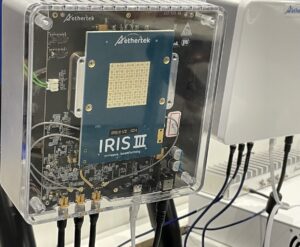
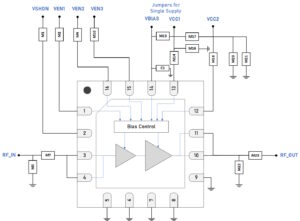
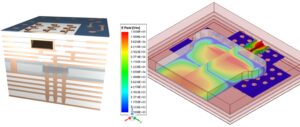
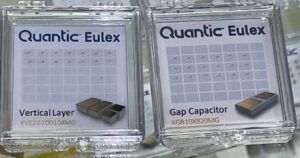

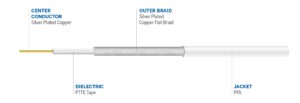
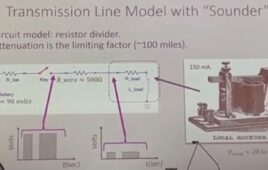

At IMS 2022 in Denver, I used a wired pair of mics in the Rhode & Schwarz booth. That was better than using a single mic, but the wireless mics work well and need no wires to trip over.
Did you attend IMS 2023? What takeaways did you get?
IMS 2024 will take place June 16-21 in Washington, DC.